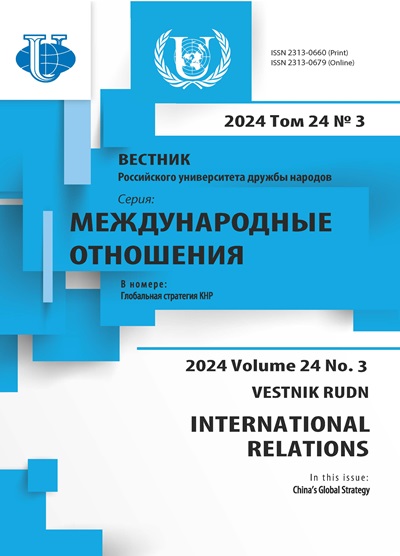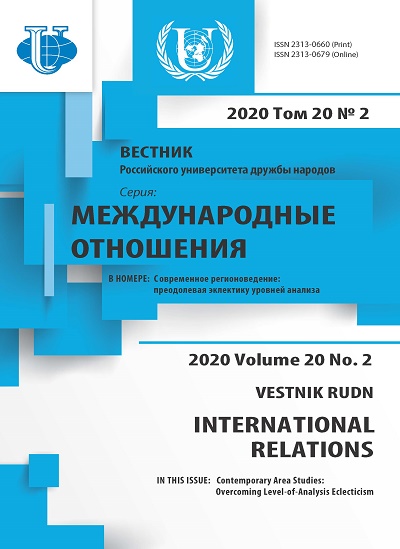Региональная экономическая интеграция в Сообществе развития Юга Африки (САДК): анализ динамики и результатов
- Авторы: Мунтшик Й.1
-
Учреждения:
- Майнцcкий университет им. Иоганна Гутенберга
- Выпуск: Том 20, № 2 (2020): Современное регионоведение: преодолевая эклектику уровней анализа
- Страницы: 333-346
- Раздел: ТЕМАТИЧЕСКОЕ ДОСЬЕ
- URL: https://journals.rudn.ru/international-relations/article/view/23974
- DOI: https://doi.org/10.22363/2313-0660-2020-20-2-333-346
Цитировать
Полный текст
Аннотация
В статье анализируется динамика и показатели региональной экономической интеграции в Сообществе развития юга Африки (САДК). Предлагается инновационный теоретический подход к анализу регионализма, который основывается на теории сотрудничества и в полной мере учитывает влияние внешних акторов. Актуальность данного исследования обусловлена развитием новой волны регионализма на Глобальном Юге. Многие из этих новых или реформированных региональных интеграционных организаций (РИО) включают развивающиеся страны, особенно в Африке. В отличие от ожиданий большинства основных интеграционных теорий в Южном полушарии появились новые региональные интеграционные группировки, которые демонстрируют значительную динамику и институциональную эффективность. Тем не менее есть свидетельства того, что регионализм на Глобальном Юге менее стабилен, чем на Севере, и не всегда полностью находится под контролем только региональных акторов. Это удивительное наблюдение, примером которого является САДК, послужило стимулом для написания данной статьи. Ее главная цель - объяснить недавнюю интеграционную динамику и эффективность организации в рамках ключевого направления деятельности, а именно в экономике. Применяя ситуационно-структурный подход для анализа динамики институтов региональной интеграции, автор утверждает, что существенная и асимметричная взаимозависимость между региональными и внерегиональными акторами оказывает двойственное влияние на архитектуру регионального сотрудничества и институциональную эффективность. В статье это иллюстрируется на примере ключевых проектов экономической интеграции САДК: зоны свободной торговли САДК и Южноафриканского таможенного союза.
Об авторах
Йоханнес Мунтшик
Майнцcкий университет им. Иоганна Гутенберга
Email: muntschick@uni-mainz.de
кандидат политических наук, научный сотрудник и профессор департамента политической науки (секция международных отношений) Майнц, Германия
Список литературы
- Amos, S. (2010). The Role of South Africa in SADC Regional Integration: the Making or Breaking of the Organization. Journal of International Commercial Law and Technology, 5 (03),124-131.
- Axelrod, R. & Keohane, R.O. (1985). Achieving Cooperation under Anarchy: Strategies and Institutions. World Politics, 38 (1), 226-254. doi: 10.2307/2010357
- Axline, W.A. (1994). The Political Economy of Regional Cooperation. Comparative Case Studies. London: Pinter Publishers and Associated University Press.
- Bach, D. (2003). New Regionalism as an Alias: Regionalisation through Trans-State Networks. In: Grant, J.A. & Söderbaum, F. (Eds.). New Regionalism in Africa. Aldershot: Ashgate. P. 21-30.
- Bergmann, J. & Niemann, A. (2015). Mediating International Conflicts: The European Union as an Effective Peacemaker? Journal of Common Market Studies, 53 (05), 957-975. doi: 10.1111/jcms.12254
- Bilal, S. & Stevens, C. (2009). The Interim Economic Partnership Agreements between the EU and African States. Contents, Challenges and Prospects. Maastricht: European Centre for Development Policy Management (ECDPM).
- Börzel, T.A. & Risse, T. (2009). Diffusing (Inter-)Regionalism. The EU as a Model of Regional Integration. KFG Working Paper. Berlin: KFG “The Transformative Power of Europe”.
- Cleary, S. (1999). Regional Integration and the Southern African Development Community. Journal of Public and International Affairs, 10 (01), 1-15.
- Doidge, M. (2011). The European Union and Interregionalism. Farnham: Ashgate.
- Draper, P. & Khumalo, N. (2009). The Future of the Southern African Customs Union. Trade Negotiations Insights, 8 (06), 4-5.
- Flatters, F. (2004). SADC Rules of Origin in Textiles and Garments: Barriers to Regional Trade and Global Integration. In: Commonwealth Secretariat. The Impact of Preferential Rules of Origin in the Textile and Clothing Sector in Africa. London: Commonwealth Secretariat. P. 41-66. DOI: 10.14217/ 9781848598454-3-en
- Gehring, T. (1994). Der Beitrag von Institutionen zur Förderung der internationalen Zusammenarbeit. Lehren aus der institutionellen Struktur der Europäischen Gemeinschaft. Zeitschrift für Internationale Beziehungen, 1 (02), 211-242
- Grobbelaar, N. (2004). Can South African Business Drive Regional Integration on the Continent? South African Journal of International Affairs, 11 (02), 91-106. doi: 10.1080/10220460409545469
- Haas, E.B. (1958). The Uniting of Europe: Political, Social, and Economic Forces 1950-1957. Stanford: Stanford University Press.
- Hettne, B. & Söderbaum, F. (1998). The New Regionalism Approach. Politeia: Journal for Political Science and Public Administration, 17 (03), 5-19.
- Keck, A. & Piermartini, R. (2008). The Impact of Economic Partnership Agreements in Countries of the Southern African Development Community. Journal of African Economies, 17 (01), 85-130. doi: 10.1093/jae/ejm006
- Keohane, R.O. & Nye, J.S. (2001). Power and Interdependence. New York, London: Longman.
- Keohane, R.O. (1984). After Hegemony. Cooperation and Discord in the World Political Economy. Princeton: Princeton University Press.
- Mair, S. & Peters-Berries, C. (2001). Regionale Integration und Kooperation in Afrika südlich der Sahara. EAC, ECOWAS und SADC im Vergleich. Bonn, München: Weltforum Verlag.
- Mattli, W. (1999). The Logic of Regional Integration: Europe and Beyond. Cambridge: Cambridge University Press.
- Moravcsik, A. (1998). The Choice for Europe: Social Purpose and State Power from Messina to Maastricht. Ithaca: Cornell University Press.
- Muntschick, J. (2012). Theorising Regionalism and External Influence: A Situation-structural Approach. Mainz Papers on International and European Politics, 02, 1-29.
- Muntschick, J. (2013). Regionalismus und Externer Einfluss: Stört die Europäische Union die Regionale Marktintegration im südlichen Afrika? Politische Vierteljahresschrift, 54 (04), 686-713.
- Muntschick, J. (2017). SADC. Extra-regional Trade Relations Contrain Deeper Market Integration. In: Krapohl, S. (Eds.). Regional Integration in the Global South. External Influence on Economic Cooperation in ASEAN, MERCOSUR and SADC. Cham: Palgrave Macmillan. P. 179-207. doi: 10.1007/978-3-319-38895-3
- Muntschick, J. (2018). Regionalism and External Influence: The Southern African Development Community (SADC) and the ambivalent Impact of the EU on Regional Integration. Cham: Palgrave Macmillan. doi: 10.1007/978-3-319-45330-9
- Nye, J.S. (1968). International Regionalism. Boston: Brown and Company
- Oye, K.A. (1985). Explaining Cooperation under Anarchy: Hypotheses and Strategies. World Politics, 38 (01), 1-24. doi: 10.2307/2010349
- Plank, F. (2017). The Effectiveness of Interregional Security Cooperation: Evaluating the Joint Engagement of the EU and the AU in Response to the 2013 Crisis in the Central African Republic. European Security, 26 (04), 485-506. doi: 10.1080/09662839.2017.1327849
- Qualmann, R. (2003). South Africa’s Reintegration Into World and Regional Markets. Trade Liberalisation and Emerging Patterns of Specialisation in the Post-Apartheid Era. Leipzig: Universität Leipzig
- Sebenius, J.K. (1983). Negotiation Arithmetic: Adding and Subtracting Issues and Parties. International Organization, 37 (02), 281-316. doi: 10.1017/S002081830003438X
- Söderbaum, F. (2004). Modes of Regional Governance in Africa: Neoliberalism, Sovereignty Boosting, and Shadow Networks. Global Governance, 10 (04), 419-436. doi: 10.1163/19426720-01004004
- Stapel, S. & Söderbaum, F. (2019). Mapping and Problematizing External Funding to the AU and the RECs. In: Engel, U. & Mattheis, F. (Eds.). The Finances of Regional Organisations in the Global South. London: Routledge
- Tjønneland, E.N. (2006). SADC and Donors - Ideals and Practices. From Gaborone to Paris and Back. Gaborone: Botswana Institute for Development Policy Analysis.
- Underdal, A. (1992). The Concept of Regime “Effectiveness”. Cooperation and Conflict, 27 (03), 227-240. doi: 10.1177/0010836792027003001
- Valentine, N. (1998). The SADC’s Revealed Comparative Advantage in Regional and International Trade. Cape Town: Development Policy Research Unit.
- Weiland, H. (2006). The European Union and Southern Africa. Interregionalism between vision and reality. Interregionalism and International Relations. London, New York: Routledge.
- Young, O.R. (1969). Interdependencies in World Politics. International Journal, 24 (04), 726-750. doi: 10.1177/002070206902400407
- Young, O.R. (1992). The Effectiveness of International Institutions: Hard Cases and Critical Variables. In: Rosenau, J.N., Czempiel, E.-O. & Smith, S. (Eds.). Governance without Government: Order and Change in World Politics. Cambridge, New York: Cambridge University Press. P. 160-194
- Yurtaev, V.I. (2016). BRICS: Challenges of Cooperation on the African Continent. Vestnik RUDN. International Relations, 16 (02), 191-202
- Zürn, M. (1987). Gerechte internationale Regime. Bedingungen und Restriktionen der Entstehung nicht-hegemonialer internationaler Regime untersucht am Beispiel der Weltkommunikationsordnung. Frankurt am Main: Haag Herchen
- Zürn, M. (1993). Problematic Social Situations and International Institutions: On the Use of Game Theory in International Politics. In: Pfetsch, F.R. (Eds.). International Relations and Pan-Europe: Theoretical Approaches and Empirical Findings. Münster: Lit-Verlag. P. 63-84











